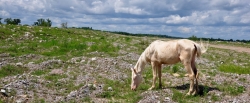Project Addresses Free-Roaming Horses
What do the academic disciplines of sociology, animal studies, agriculture, wildlife management and aviation have in common?
Faculty and students from those respective departments at Eastern Kentucky University are pooling their diverse areas of expertise to address the growing presence of free-roaming herds of horses in rural southeastern Kentucky.
On Saturday morning, Feb. 25, EKU aviation instructor Randall Humphries, flanked by junior animal studies major Katelyn Wagner, will board a University plane at Central Kentucky Regional Airport in Madison County and head for Breathitt County. Awaiting them at the Julian Carroll Airport near Jackson will be Dr. Stephanie McSpirit, professor of sociology, and Dr. Ed Fredrickson, associate professor of agriculture.
After a brief discussion of logistics, Humphries and Wagner will head back to the skies over Breathitt County at approximately 10 a.m. to allow Wagner to perform an aerial inventory of the horses. It has been estimated from ground studies that between 200 and 400 horses are freely roaming the 492 square miles of Breathitt County.
Fredrickson, whose specialty is rangeland ecology, said the abandonment of horses was an unintended consequence of mine site reclamation without following a longer-term management plan that considers carrying capacity of the site. To “better define the problem,” a 924-acre reclaimed mine site in Breathitt County was selected for a ground survey, with horse and wildlife surveys conducted using three strategically based camera traps baited with equine mineral blocks for 14-day intervals. More than 75 horses were recorded within the study site, along with 26 elk and 44 deer visitations. About 5 percent of the horses appeared to require veterinary care due to poor body conditions, or visible disease, and vegetation surveys suggested “severe” overgrazing, with grasses replaced by “unpalatable” plant species.
McSpirit added that many of the horses were released during the 2009 economic downturn and have increased in numbers the past eight years. “There may also be a common practice of releasing some horses to winter on the strip job and bring in during the spring. The fact that some of the horses are indeed owned by residents in the area must be considered in developing a viable and workable management plan that the community supports. We are in the process of starting interviews with residents and community officials to get feedback and perspective on that front.”
The flyover, McSpirit said, will “help the county and other groups and organizations form sound management plans. The Breathitt County herd is unique in that many in the community see this herd as a potential asset, rather than a nuisance, and there are plans for a horse viewing center. Maintaining a healthy herd and determining what might be a stable population size is important to those efforts in developing a management plan.”
Management of resources supporting the horses “is also important to ensure adequate water quality and quantity for local populations and downstream users,” Fredrickson said. “This requires that horse populations do not exceed the carrying capacity of a disturbed reclamation site with poor soil development and fragile plant populations.”
McSpirit, who also has a background in natural resource management, said she hopes the Breathitt flyover can serve as a model for future efforts. “Most counties in eastern Kentucky have a herd of free-roaming horses,” she said, “and, no doubt, would like a population count on these herds as a first start in developing a management plan that will benefit the community and the welfare of these horses. We hope to compare aerial counts with on-the-ground counts to determine what methods are most effective in conducting herd inventories.”
The idea for the project started with a since-graduated animal studies major, Sarah Oliver, who approached McSpirit in Fall 2015 about such a study. At that point, Fredrickson and another student, Heather Donlan, a current wildlife management major, were recruited to assist. The four secured a $7,000 grant from the University Scholarship Fund to study the Breathitt County herd. The grant provided funds for Oliver and Donlan to conduct interviews and a ground survey, and for the flyover.
An excited Wagner, of Lawrenceburg, Indiana, said she “can’t wait” for the flyover. “As an animal studies major, it is an interest to me as I would like to eventually go out west to study wild horses and their interactions with local farmers as well as in other areas. Horses have always been a part of my life. I have had a particular interest in them since I was a child.”
Dennis Sinnett, the newly named coordinator of the EKU Aviation Program, the only such program based at a Kentucky college or university, said: “The entire aviation department is excited about the opportunity to ... assist in a worthy project by providing access to University assets that can prove beneficial in supporting other departments. Dr. (Tim) Ross (chair of the Department of Applied Engineering and Technology) and the entire aviation staff have been fully supportive of the initiative, and we look forward to the opportunity to assist in the future. This is viewed as a win-win across the board.”
The results of the Feb. 25 aerial survey will be shared with Breathitt Countians and horse welfare organizations “in the very near future,” McSpirit said, adding that some of the research will also be presented at the annual “Living with the Animals” conference at EKU in March. The conference is hosted by EKU’s animal studies program, the first program of its kind in the world.
Anyone who would like to share their perspective on the horses and would like to be interviewed for the study (anonymity assured) is asked to contact McSpirit at 859-622-3070.
Published on February 22, 2017
